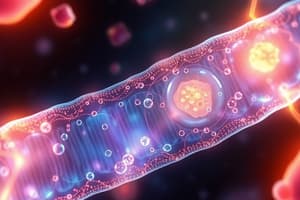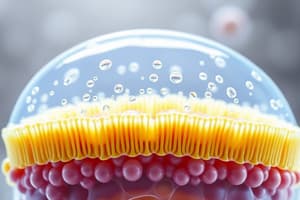Podcast
Questions and Answers
What is the primary reason phospholipids are essential for cell membranes?
What is the primary reason phospholipids are essential for cell membranes?
- They provide structural rigidity to the cell membrane.
- They form a fluid barrier that separates the internal and external environments. (correct)
- They are involved in synthesizing complex carbohydrates
- They facilitate the rapid movement of all molecules across the membrane.
According to the fluid mosaic model, what is the nature of protein movement within the cell membrane?
According to the fluid mosaic model, what is the nature of protein movement within the cell membrane?
- Proteins are immobile and fixed within the membrane.
- Proteins move freely but more slowly than phospholipids. (correct)
- Proteins are only able to vibrate and flex, but not move laterally.
- Proteins move as rapidly as the phospholipids within the membrane.
The term 'mosaic' in the fluid mosaic model refers to what characteristic of the cell membrane?
The term 'mosaic' in the fluid mosaic model refers to what characteristic of the cell membrane?
- The regular arrangement of carbohydrates on the membrane's outer surface.
- The symmetrical distribution of lipids and proteins.
- The presence of many different types of proteins embedded within the membrane. (correct)
- The consistent and uniform arrangement of phospholipids.
What is the approximate thickness of the phospholipid bilayer in a cell membrane?
What is the approximate thickness of the phospholipid bilayer in a cell membrane?
Which of the following is TRUE regarding the asymmetry of the cell membrane?
Which of the following is TRUE regarding the asymmetry of the cell membrane?
What is the function of glycoproteins and glycolipids in the cell membrane?
What is the function of glycoproteins and glycolipids in the cell membrane?
How do hormones and growth factors interact with the cell membrane to initiate an internal response?
How do hormones and growth factors interact with the cell membrane to initiate an internal response?
What might occur if serotonin is not binding correctly to its receptors at nerve cell synapses?
What might occur if serotonin is not binding correctly to its receptors at nerve cell synapses?
What is the primary function of sterols within a phospholipid bilayer?
What is the primary function of sterols within a phospholipid bilayer?
How does the degree of unsaturation in fatty acids affect membrane fluidity?
How does the degree of unsaturation in fatty acids affect membrane fluidity?
Which type of membrane protein is characterized by having hydrophobic segments embedded within the lipid bilayer and hydrophilic regions exposed to the environment?
Which type of membrane protein is characterized by having hydrophobic segments embedded within the lipid bilayer and hydrophilic regions exposed to the environment?
Which of the following BEST describes the function of membrane proteins in cell signaling?
Which of the following BEST describes the function of membrane proteins in cell signaling?
What effect does increasing temperature have on the fluidity of the phospholipid bilayer?
What effect does increasing temperature have on the fluidity of the phospholipid bilayer?
A protein that is located on the surface of the membrane, and not embedded within the lipid bilayer, would be classified as what?
A protein that is located on the surface of the membrane, and not embedded within the lipid bilayer, would be classified as what?
Which of the following is NOT a function of membrane proteins?
Which of the following is NOT a function of membrane proteins?
What distinguishes transmembrane proteins from integral membrane proteins?
What distinguishes transmembrane proteins from integral membrane proteins?
Flashcards
Membrane Fluidity
Membrane Fluidity
The ability of the phospholipid bilayer to move and change shape, allowing flexibility and transportation.
Fatty Acid Saturation and Fluidity
Fatty Acid Saturation and Fluidity
The degree of unsaturation in fatty acid chains directly affects membrane fluidity. Saturated fatty acids pack tightly, making the membrane less fluid, while unsaturated fatty acids with kinks create gaps, increasing fluidity.
Temperature and Fluidity
Temperature and Fluidity
Temperature plays a crucial role in membrane fluidity. Colder temperatures decrease fluidity, making the membrane more rigid. Conversely, warmer temperatures increase fluidity, making the membrane more flexible.
Sterol's Role in Membrane Fluidity
Sterol's Role in Membrane Fluidity
Signup and view all the flashcards
Integral Membrane Protein
Integral Membrane Protein
Signup and view all the flashcards
Peripheral Membrane Protein
Peripheral Membrane Protein
Signup and view all the flashcards
Transmembrane Protein
Transmembrane Protein
Signup and view all the flashcards
Transport Proteins
Transport Proteins
Signup and view all the flashcards
Why are phospholipids important for cell membranes?
Why are phospholipids important for cell membranes?
Signup and view all the flashcards
What is the Fluid Mosaic Model?
What is the Fluid Mosaic Model?
Signup and view all the flashcards
What is the phospholipid bilayer?
What is the phospholipid bilayer?
Signup and view all the flashcards
What does 'Fluid' mean in the fluid mosaic model?
What does 'Fluid' mean in the fluid mosaic model?
Signup and view all the flashcards
What does 'Mosaic' mean in the fluid mosaic model?
What does 'Mosaic' mean in the fluid mosaic model?
Signup and view all the flashcards
Is the cell membrane symmetrical?
Is the cell membrane symmetrical?
Signup and view all the flashcards
What is a glycoprotein?
What is a glycoprotein?
Signup and view all the flashcards
What is a glycolipid?
What is a glycolipid?
Signup and view all the flashcards
Study Notes
Plasma Membrane Composition and Function
- The plasma membrane is a semipermeable barrier, selectively controlling what enters and exits the cell.
- It's composed of a phospholipid bilayer, with hydrophobic tails facing inward and hydrophilic heads facing outward.
- Proteins are embedded within the phospholipid bilayer, performing various functions like transport, enzymatic activity, and signal reception.
- Carbohydrates are attached to proteins (glycoproteins) and lipids (glycolipids), often involved in cellular recognition and signaling.
- Cholesterol is another component, regulating membrane fluidity and preventing it from being too rigid at low temperatures or too fluid at high temperatures.
- The fluid mosaic model describes the dynamic arrangement of lipids and proteins in the cell membrane. Phospholipids and proteins can move laterally, allowing for flexibility and dynamism.
Phospholipids
- Phospholipids are essential components of the cell membrane, forming a bilayer.
- They have a hydrophilic head (attracted to water) and two hydrophobic tails (repelled by water).
- This dual nature causes the phospholipids to arrange themselves in a bilayer, with the tails clustering inward and the heads facing outward.
Fluid Mosaic Model
- The fluid mosaic model depicts the cell membrane as a dynamic structure.
- Lipids and proteins are not static; they can move laterally within the membrane.
- The movement allows for flexibility and adaptability of the membrane.
Membrane Proteins
- Proteins embedded in the membrane perform diverse functions.
- Some proteins act as transporters to facilitate the passage of specific substances.
- Others serve as enzymes to catalyze chemical reactions.
- Receptor proteins bind to specific molecules, triggering intracellular responses.
- Anchor proteins connect the membrane to other structures within or outside the cell.
Membrane Protein Types
- Transport Proteins: move substances across the membrane.
- Enzymatic Proteins: catalyze biochemical reactions.
- Attachment Proteins: attach to cytoskeleton or extracellular matrix for support.
- Recognition Proteins: identify cell type or foreign substances for immune response.
- Signal Proteins: transmit signals within or between cells.
Membrane Structure
- Integral proteins: embedded within the membrane.
- Peripheral proteins: attached to the surface of the membrane.
- Transmembrane proteins: span the entire membrane.
Fluidity
- Factors affecting membrane fluidity include temperature and lipid composition.
- Higher temperatures increase fluidity. Lower temperatures decrease fluidity.
- Saturated fatty acids restrict fluidity, while unsaturated fatty acids increase it.
- Sterols like cholesterol moderate fluidity, preventing extremes.
Studying That Suits You
Use AI to generate personalized quizzes and flashcards to suit your learning preferences.
Related Documents
Description
This quiz explores the structure and function of the plasma membrane, a critical component of all cells. It highlights the roles of phospholipids, proteins, carbohydrates, and cholesterol in maintaining membrane integrity and fluidity, as well as the fluid mosaic model. Test your knowledge on how these components work together to control cellular processes.




